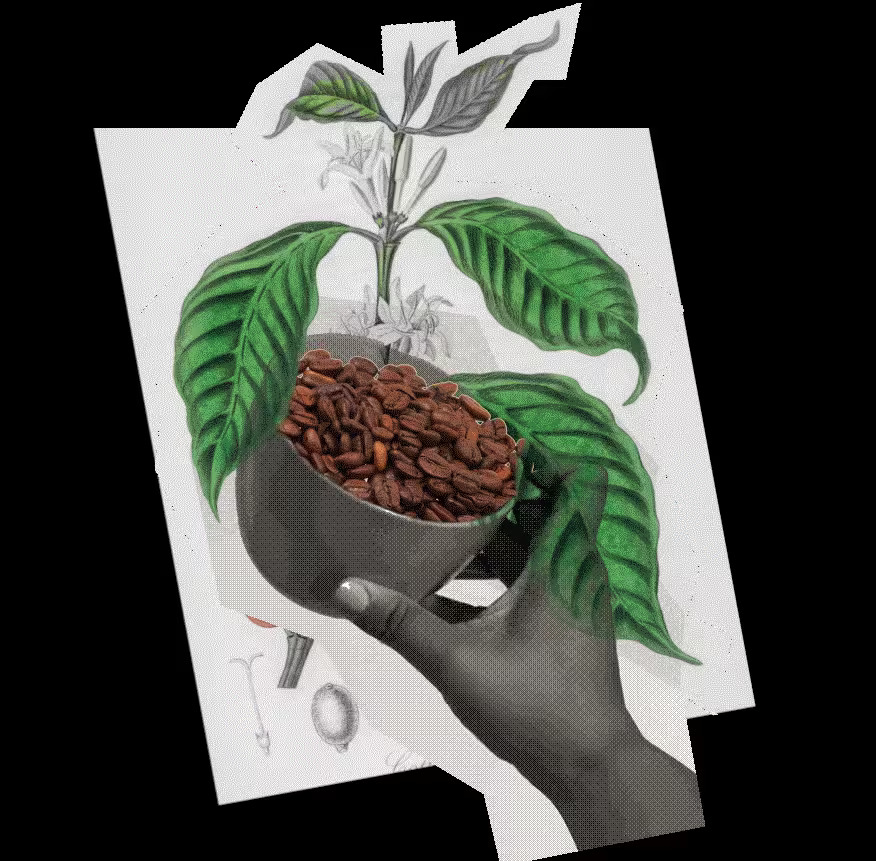Coffee’s Sustainability Problem
A research article by Sara Swenson
May 24, 2024
Key Takeaways
- The conventional model for growing coffee (sun-grown, monoculture, agrochemicals) is unsustainable and contributes to deforestation, soil degradation and erosion, water stress and toxicity, and human rights issues.
- Sustainable agricultural practices (shade-grown, agroforestry, limiting agrochemicals) provide solutions to the problems with conventional coffee growing methods.
- There are various stakeholders, including scientists, farmers, organizations, startups, and governments working to solve coffee’s sustainability crisis and promote its long-term viability.
Coffee has a major sustainability problem, and our team at Greener Beans wants to spread the word, and make it easier for consumers to understand this complex landscape, and be able to access the most credible information on the subject. This article aims to discuss what makes the current coffee industry so unsustainable, and explore the various methods we can deploy to grow coffee in a greener and more equitable way. In addition, we hope that coffee consumers like you can walk away better equipped to make sustainable choices on an individual level.
Let’s first start with the facts: Coffee is the fifth highest emitter of greenhouse gasses in the agricultural industry, ranking one spot below beef (dairy herd), and has the second highest emissions of a plant-based food product (Source). Let’s explore the factors that contribute to coffee’s outsized emissions.
Unsustainable Farming Practices in the Coffee Industry
The following section will outline the major contributors to coffee’s greenhouse emissions at the farming stage. It’s important to note that while land change practices (i.e. deforestation), and conventional agricultural practices comprise 51% of coffee’s total emissions , losses account for 38.5%, the same amount as farming (Source). Losses are the emissions produced from the loss of a food product before reaching the consumer, therefore not to be confused with food waste, which is produced by consumers. For now, we’ll look into farming practices contributing to coffee’s carbon emissions.
Land Change Practices - Deforestation
A significant factor contributing to coffee’s large carbon footprint is its outsized role in deforestation. Under conventional agricultural practices, coffee is grown as a full-sun monocrop, which requires large swathes of land to grow. It grows particularly well in areas that also happen to be HVC areas (High Conservation Value) - areas which are defined by the Forest Stewardship Council as possessing characteristics which are vital to protect, including species diversity and cultural values (Source). Poor farm management and practices that degrade soil health often make it more economical for farms to resort to clear cutting instead of restoring the land in current use (Source),(Source). It’s also important to note the role of climate change in this process. The range of suitable regions for growing coffee is changing rapidly with climate change, encouraging the expansion of deforestation to areas more climatically suitable for coffee growing. For more information on this topic, refer to our article on Climate Change’s impact on the coffee industry.
Sun-Grown Monocultures vs. Shade-Grown
Coffee is typically sun-grown, which essentially means it is grown without any cover crops in a monoculture. Picture a tract of land with rows of coffee plants, and that’s it. No trees to create shade, no non-coffee plants to increase biodiversity, just coffee. The problem with this system, like any monoculture practices, is that it destroys soil health in a short amount of time (in addition to pesticide use), absorbs heat in an already warming climate, and prevents biodiversity from flourishing.
The alternative to sun-grown coffee is shade-grown, a type of agroforestry (also known as regenerative agriculture) that balances farm output and biodiversity. Like its name, shade-grown coffee farms use large trees and groundcover to achieve multiple sustainability goals in one. Large trees typically come with immense networks of mycorrhizae, or fungi, which play a large role in soil health. In addition, these fungi networks prevent erosion by stabilizing the ground underneath. Finally, large trees can create their own microclimate, and significantly reduce local temperatures on a coffee farm - a crucial way to mitigate climate change on a small scale (Source), (Source). In addition to all of these benefits, agroforestry has high carbon sequestration potential (Source).
It was not until the 1970s when sun-grown coffee grew in popularity, largely due to a rise in demand, and government subsidies that encouraged the use of pesticides in order to significantly increase yields (Source). Prior to the 1970s, shade-grown was the norm. It’s important to note that many climate change solutions reside in technology or knowledge we already possess.
Agrochemicals vs. Organic
The usage of agrochemicals (pesticides, fungicides, fertilizers), can be a controversial topic, particularly when it comes to sustainability. In theory, agrochemicals are intended to benefit the health of the plant by providing nutrients and preventing disease. However, agrochemicals are typically used without consideration of dosage, and are administered at levels that are detrimental to soil health, ecosystem health, and human health. The solution to this issue requires a complicated balance between organic agricultural practices, and calculated dosages of agrochemicals based on scientific evidence. In an ideal world, a coffee farm would not need to use agrochemicals, yet it’s also important to note that transitioning from a monoculture farm to a sustainable one is a process, and therefore progress will be incremental (Source),(Source),(Source).
Water Intensity and Wastewater
Coffee is a water intensive crop, and when grown unsustainably it can create water stress for its local community and lead to agrochemical runoffs that leach into downstream water systems. It takes roughly 140 liters of water to produce one cup of coffee, and out of one kilogram of coffee produced, it typically takes 337 liters of water, when weighted with the water scarcity of its local area (Source),(Source). Coffee cultivation predominantly occurs on sloping terrain, where the application of agrochemicals can lead to runoff, eventually contaminating broader water systems and local drinking water sources. Given that numerous agrochemicals carry substantial health hazards for humans, their usage and effective water management emerge as critical social concerns, intertwining with sustainability objectives (Source), (Source). There are multiple related solutions to coffee’s water problem. As discussed above, shade grown coffee creates microclimates and can help coffee farms retain water within the soil, cutting water needs significantly. Broad fungi networks stabilize the soil and reduce “run off,” and trees and plants experience ‘Transpiration,” the slow absorption and evaporation of water, keeping water used within a more closed loop (Source).
Erosion
When considering the cumulative effects of sun-growing coffee using agrochemicals on steep slopes, the result is a highly unstable environment prone to erosion, which threatens the future of coffee growing, and any communities located below. Paired with increasing extreme weather events, this approach threatens yields, long-term viability of farms, and especially the safety of communities surrounding the farm. The solutions to erosion are interconnected with the solutions to soil health, biodiversity. The healthier and more diverse the entire system is, the more stable it is, literally.
Human Rights
As we’ve seen above, many unsustainable practices also negatively affect human wellbeing; however, sustainable practices should never come at the expense of human rights either. Coffee growing is not immune to some of the worst human rights violations, including forced labor, child labor, and inconceivably low wages. In addition, high price volatility and varying farming subsidies generally make it challenging for farms to adopt sustainable practices and instate fair labor practices. While the focus of this article is sustainable farming practices, it’s essential to note the complex interplay between sustainability and human rights, and ensure that approaches incorporate both (Source), (Source).
Shedding Light on Coffee’s Sustainability Problem
Now that you better understand coffee’s sustainability problem, and are familiar with some solutions, we hope you feel better equipped to make sustainable choices yourself. While there is no silver bullet solution to these issues, there is a wide range of stakeholders working on making coffee more sustainable and ethical. On the non-profit research end, (World Coffee Research) is a great resource for information on sustainability within the coffee industry. Nonprofits such as (Rainforest Alliance) have created sustainability and social impact certifications which include auditing of individual farms. There are various roasters known for their sustainable practices, such as (Counter Culture Coffee). The EU and other governments are involved in further passing regulations which aim to prevent deforestation, such as the (EUDR). Finally there are various startups working within the reforestry/agroforestry space, such as (Courageous Land). If you’re interested in exploring more information regarding coffee and sustainability, feel free to refer to our articles on Climate Change’s effect on coffee growing, the various Certifications and what they mean, and case studies on individual farms committed to sustainable practices.






